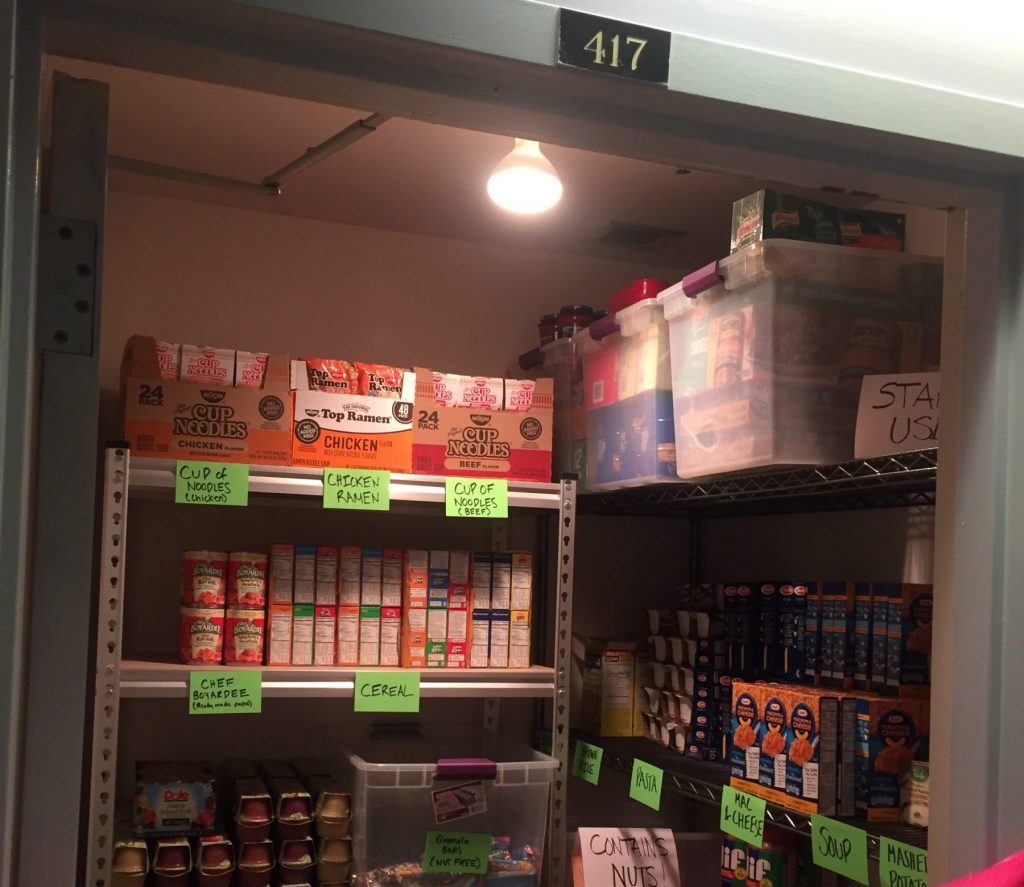GUSA’s Hoya Hub food pantry opened on Oct. 1 in the Leavey Center, kicking off what organizers hope will be a long and effective campaign to fight food insecurity on Georgetown’s campus.
The food pantry, located in Leavey 417, will require students to fill out an online form answering basic biographical questions. After giving their GU ID number, students will receive the code to open the door to the pantry. Hoya Hub Vice-Chair Sam Dubke (SFS ’21) said that the Hub will be a resource available to all undergraduate and graduate students as well as faculty and staff members.

The Hoya Hub food pantry in Leavey 417
“Essentially, if you have a GOCard, you can use it. We didn’t want anybody to have to demonstrate need,” Dubke said. “It’s very much an honor system.”
The food pantry is stocked with pasta, beans, rice, peanut butter, and other non-perishable goods. Dubke said that the Hoya Hub team worked with professors who have researched food justice to determine what foods would be the most helpful to provide to students.
“Our focus is mainly meals, rather than snack foods,” Dubke said. “We tried to steer away from granola bars and more towards rice, and beans, and something that you can take and put on the shelf in your apartment and that can feed you 2 to 3 meals a week.”
Caroline Barnes (COL ’19), GUSA’s socioeconomic chair and chair of the Hoya Hub, praised the university’s involvement in getting the Hoya Hub off the ground.
“It takes a village,” Barnes said, citing the Center for Social Justice, Center for Student Engagement, SaxaFund, the Corp, and Georgetown alumni as the funders of the Hub. “They have been really phenomenal in supporting our efforts.”
Barnes began to take interest in food insecurity in high school, and she said the Hoya Hub was the perfect passion project for her senior year.
“I was always fascinated with this paradox of food waste and hunger. How is there all this food that’s not going somewhere, and yet there’s this issue of hunger?” Barnes said. Her interest grew after the results of a 2016 GUSA survey were released, revealing that 54% of the 351 students polled had experienced food insecurity at Georgetown.
“Those stats were pretty shocking even to me,” Barnes said. “How could people here at Georgetown experience that?”
Organizers of the Hoya Hub hope to eventually expand to a larger space than the one they are currently in, and would like to work out a way to stock perishable foods as well. Both Barnes and Dubke said that members of the Corp have reached out to them about donating food left over at the end of the day to the Hoya Hub, but that the initiative does not yet have the facilities to accommodate anything but canned and dry goods.
GUSA’s efforts to fight food insecurity on Georgetown’s campus have caught the attention of other students. Izzy Ortiz (MSB ’20) is working with the national organization Swipe Out Hunger to bring a new chapter to Georgetown. Swipe Out Hunger currently has chapters on 49 campuses across the country, and Ortiz said she would ultimately like to see Georgetown implement an initiative that would allow students to donate meal swipes left over at the end of the week or the semester to others in need.
“We want to work on erasing the stigma around food insecurity and make sure that all of the students on campus are comfortable and they’re not hungry,” Ortiz said.
Organizers of the Hoya Hub hope that the pantry’s opening will be the beginning of a prolonged effort to eradicate hunger at Georgetown.
“A food pantry is one of the answers to food insecurity on campus, but it’s not the only answer,” Dubke said. “We see the Hoya Hub as not just a food pantry but also as an umbrella term for all of these groups on campus fighting food insecurity.”
As she cut the streamers draped across the door of the food pantry on Monday, Barnes agreed with him. “The support has always been there, the need has always been there. This really is just the beginning of it all.”





